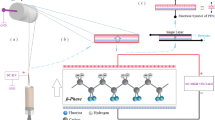Abstract
This study develops a coupled multiphysics finite element method for the dynamic analysis of a bare flexible electrodynamic tether. Contrary to the existing methods, the new method discretizes and solves the orbital motion limited equation and the dynamic equation of an elastic flexible tether simultaneously. First, the new method is verified via comparison with the existing methods in a straight tether situation. Second, the number of tether elements, tether bending deformation, and two design parameters at the cathodic end affecting the electrical current are investigated. It is determined that the tether bending deformation and the two parameters i.e., the impedance Z T and Φ PW have a significant impact on the electron collection efficiency of an electrodynamic tether system. The results indicate that the proposed method should be applied in the refined mission analysis.
Similar content being viewed by others
References
Shan M, Guo J, Gill E. Review and comparison of active space debris capturing and removal methods. Prog Aeosp Sci, 2016, 80: 1–32
Macdonald M, McInnes C, Bewick C, et al. Concept-of-operations disposal analysis of spacecraft by gossamer structure. J Spacecr Rockets, 2015, 52: 517–525
Sanmartin J R, Lorenzini E C, Martinez-Sanchez M. Electrodynamic tether applications and constraints. J Spacecr Rockets, 2010, 47: 442–456
Yu B, Wen H, Jin D, et al. Theory and experiment of space electrodynamic tether systems. Adv Mech, 2016, 46: 226–266
Takeichi N. Practical operation strategy for deorbit of an electrodynamic tethered system. J Spacecr Rockets, 2006, 43: 1283–1288
Wen H, Jin D, Hu H. Three-dimensional deployment of electro-dynamic tether via tension and current control with constraints. Acta Astronaut, 2016, 129: 253–259
Zhang J, Zhu Z H, Sun Z W. Reduction of libration angle in electrodynamic tether deployment by Lorentz force. J Guid Control Dyn, 2016, 40: 164–169
Kawamoto S, Makida T, Sasaki F, et al. Precise numerical simulations of electrodynamic tethers for an active debris removal system. Acta Astronaut, 2006, 59: 139–148
Li G, Zhu Z H, Meguid S A. Libration and transverse dynamic stability control of flexible bare electrodynamic tether systems in satellite deorbit. Aerosp Sci Technol, 2016, 49: 112–129
Wen H, Zhu Z H, Jin D, et al. Model predictive control with output feedback for a deorbiting electrodynamic eTther system. J Guid Control Dyn, 2016, 39: 2455–2460
Li G, Zhu Z H, Ruel S, et al. Multiphysics elastodynamic finite element analysis of space debris deorbit stability and efficiency by electrodynamic tethers. Acta Astronaut, 2017, 137: 320–333
Li G, Zhu Z H. Multiphysics finite element modeling of current gneration of bare flexible electrodynamic tether. J Propul Power, 2017, 33: 408–419
Pelaez J, Sanjurjo M. Generator regime of self-balanced electrodynamic bare tethers. J Spacecr Rockets, 2006, 43: 1359–1369
Sanjurjo-Rivo M, Sáchez-Arriaga G, Peláz J. Efficient computation of current collection in bare electrodynamic tethers in and beyond OML regime. J Aerosp Eng, 2015, 28: 04014144–04014151
Sáchez-Arriaga G, Bombardelli C, Chen X. Impact of nonideal effects on bare electrodynamic tether performance. J Propul Power, 2015, 31: 951–955
Lanoix E L M, Misra A K, Modi V J, et al. Effect of electromagnetic forces on the orbital dynamics of tethered satellites. J Guid Control Dyn, 2005, 28: 1309–1315
Rocchi A, Lavagna M. Versatile electro-dynamic tethers dynamics simulator for debris mitigation tools design. In: Proceedings of the 13th Symposium on Advanced Space Technologies in Robotics and Automation, Noordwijk, 2015. 96077–96085
Zanutto D, Lorenzini E C, Mantellato R, et al. Orbital debris mitigation through deorbiting with passive electrodynamic drag. In: Proceedings of the 63th International Astronautical Congress, Naples, 2012. 1–9
Zhong R, Zhu Z H. Long-term libration dynamics and stability analysis of electrodynamic tethers in spacecraft deorbit. J Aerosp Eng, 2014, 27: 04014020–04014033
Li G, Zhu Z H, Cain J, et al. Libration control of bare electrodynamic tethers considering elastic-thermal-electrical coupling. J Guid Control Dyn, 2016, 39: 642–654
Li G Q, Zhu Z H. Precise analysis of deorbiting by electrodynamic tethers using coupled multiphysics finite elements. J Guid Control Dyn, 2017
Wang C, Li G, Zhu Z H, et al. Mass ratio of electrodynamic tether to spacecraft on deorbit stability and efficiency. J Guid Control Dyn, 2016, 39: 2192–2198
Sun F, Zhu Z, LaRosa M. Dynamic modeling of cable towed body using nodal position finite element method. Ocean Eng, 2011, 38: 529–540
Li G Q, Zhu Z H. Long-term dynamic modeling of tethered spacecraft using nodal position finite element method and symplectic integration. Celest Mech Dyn Astr, 2015, 123: 363–386
Sanmartin J, Martinez-Sanchez M, Ahedo E. Bare wire anodes for electrodynamic tethers. J Propul Power, 1993, 9: 353–360
Zhu Z H. Dynamic modeling of cable system using a new nodal position finite element method. Int J Numer Meth Biomed Eng, 2010, 26: 692–704
Zhu Z H. Mission design for a cubesat deorbit experiment using an electrodynamic tether. In: Proceedings of AIAA/AAS Astrodynamics Specialist Conference, Long Beach, 2016. 5573–5579
Acknowledgments
This work was supported by Discovery Grant and Discovery Accelerate Supplement Grant of Natural Sciences and Engineering Research Council of Canada.
Author information
Authors and Affiliations
Corresponding author
Rights and permissions
About this article
Cite this article
Li, G., Zhu, Z.H. Parameter influence on electron collection efficiency of a bare electrodynamic tether. Sci. China Inf. Sci. 61, 022201 (2018). https://doi.org/10.1007/s11432-017-9219-1
Received:
Revised:
Accepted:
Published:
DOI: https://doi.org/10.1007/s11432-017-9219-1




